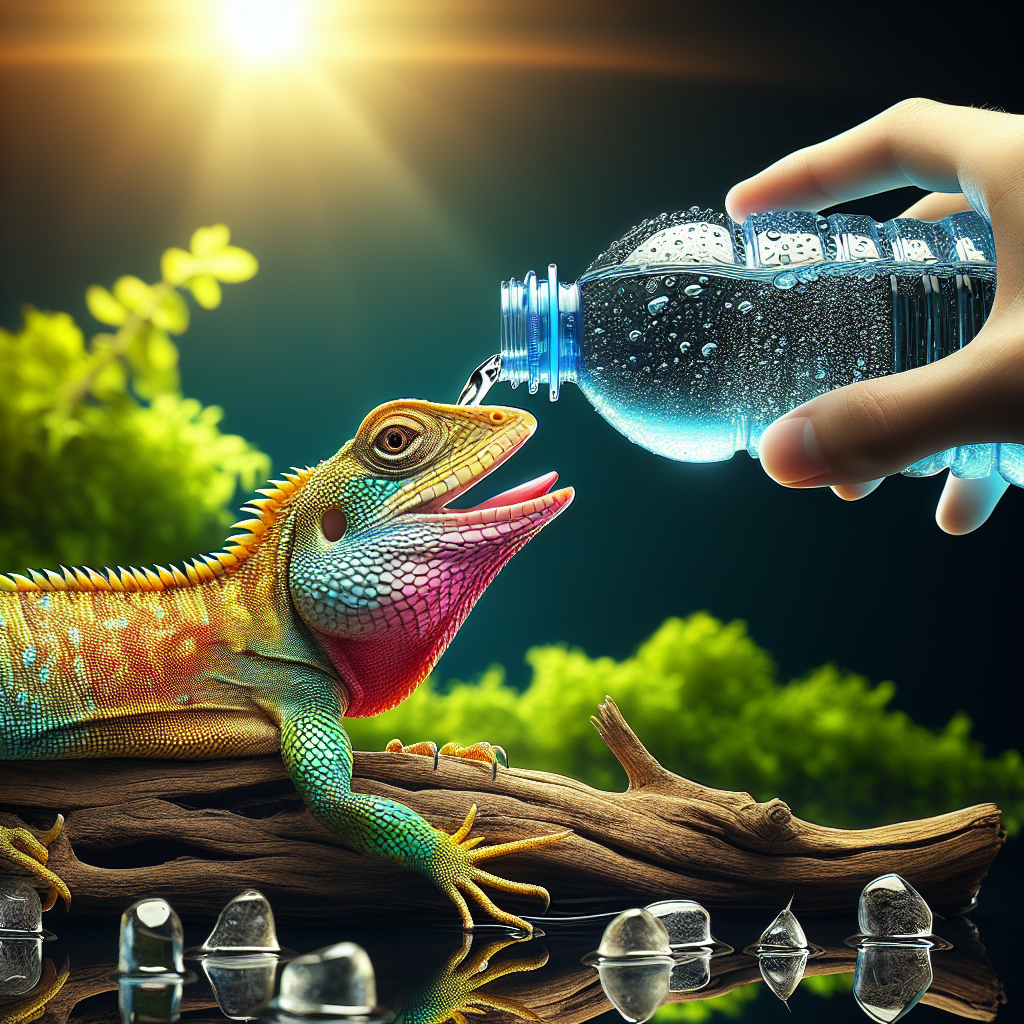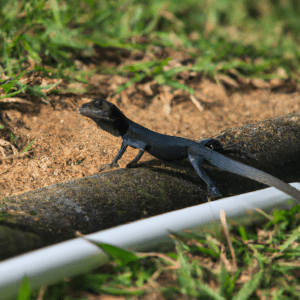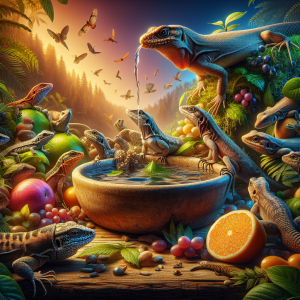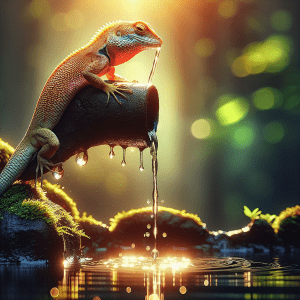Importance of Hydration for Active Lizards
Let me tell you, hydration is key when it comes to keeping our scaly friends healthy and happy. Remember that time we went hiking and forgot our water bottles? We were parched, right? Well, lizards feel the same way when they don’t have enough water to drink.
Lizards are fascinating creatures, and they have specific hydration needs that are different from mammals like us. Did you know that some lizard species absorb water through their skin? It’s like having a built-in hydration system! But despite their cool adaptations, lizards still rely on fresh water for drinking to stay properly hydrated.
Now, here’s where things get interesting. Imagine trying to tell if a lizard is dehydrated. Unlike us, lizards can’t just say, “Hey, I need a drink!” Instead, they might exhibit subtle signs like sunken eyes or wrinkled skin. It’s up to us lizard owners to observe their behavior and appearance to ensure they’re getting enough water.
To keep our scaly pals hydrated and thriving, we need to provide them with a suitable water source in their habitat. Whether it’s a shallow dish for drinking or misting their enclosure to create humidity, there are various ways to ensure lizards have access to water throughout the day.
And here’s a practical tip for you: consider the type of lizard species you have when setting up their hydration routine. Some lizards prefer to drink from standing water, while others may benefit from regular misting to simulate their natural environment. By tailoring their hydration plan to their species’ needs, we can help them lead a healthy and hydrated life.
So, the next time you see your active lizard basking under the heat lamp, remember the importance of hydration in their daily routine. Keeping them well-watered is not just about quenching their thirst but also about supporting their overall health and well-being.
Understanding Lizard Hydration Needs
Have you ever stopped to think about how important hydration is for lizards? It’s not just about providing water; it’s about understanding their unique hydration needs to keep them healthy and happy.
Let me share an interesting fact with you. Did you know that lizards absorb water not only by drinking but also through their skin? It’s fascinating how these creatures have evolved to adapt to their environment. Understanding this aspect of lizard hydration is crucial in ensuring they receive adequate moisture.
When it comes to understanding lizard hydration needs, one practical tip is to observe your pet’s behavior. Different lizard species have varying water requirements, so it’s essential to pay attention to how much water your lizard consumes and how frequently they drink. This observation can give you valuable insights into their hydration needs.
Now, let’s delve into the challenge of providing proper hydration to lizards. One common mistake many lizard owners make is underestimating the importance of a consistent hydration routine. Just like us, lizards need a steady supply of water to stay hydrated, healthy, and active. Establishing a hydration routine that works for your lizard’s species can help prevent dehydration and related health issues.
Thinking about the broader implications of lizard hydration, it’s not just about keeping them hydrated in the present moment. Adequate hydration plays a significant role in their overall well-being and longevity. By prioritizing hydration and understanding the specific needs of your lizard, you’re investing in their health and happiness for the long term.
So, remember, when it comes to keeping your active lizard well-hydrated, knowledge is power. By learning more about their hydration requirements and implementing effective hydration strategies, you can ensure that your scaly friend thrives in their environment.
Signs of Dehydration in Lizards
Signs of dehydration in lizards are crucial to watch out for, especially for our scaly friends who can’t just vocalize their thirst like we can. You know, it reminds me of that one time we were out hiking, and I forgot my water bottle. Boy, did I feel the effects of dehydration soon enough! Just like us, lizards rely on water for their survival and well-being.
It’s fascinating to note that lizards have evolved to be efficient at conserving water, but they can still become dehydrated if they don’t have access to enough water sources. So, when it comes to our pet lizards, we need to be vigilant in recognizing signs that they might be lacking the hydration they need.
Imagine your lizard buddy feeling sluggish, with sunken eyes, dry skin, or reduced appetite. These are all red flags that your scaly pal might be in need of a water refill. It’s like their way of saying, “Hey, I could use a drink over here!”
To avoid reaching that point, it’s essential to provide your active lizard with a constant supply of fresh water and regularly monitor their hydration levels. By being proactive and observant, you can ensure that your pet lizard stays healthy and hydrated. Remember, prevention is key when it comes to dehydration in lizards!
So, next time you see your lizard acting a bit off, take a moment to check for those telltale signs of dehydration. Your vigilant eye and care can make all the difference in keeping your scaly companion happy and hydrated. After all, a hydrated lizard is a happy lizard!
Best Practices for Providing Water to Active Lizards
Have you ever wondered how to ensure your active lizard stays well-hydrated? Let me tell you about the best practices for providing water to your scaly friend.
When I first got my bearded dragon, I was puzzled about how much water he needed. That’s when I realized the importance of offering water in a way that suits his active nature. Active lizards, like bearded dragons or geckos, require access to fresh water at all times. They tend to drink during the day, so it’s crucial to observe their water intake and adjust accordingly.
One interesting fact about lizard hydration is that some species prefer to drink water droplets off leaves or surfaces rather than from a bowl. This behavior mimics how they would drink in the wild, making it essential to provide alternative hydration methods besides a water dish.
To ensure your active lizard is adequately hydrated, consider offering a shallow water dish that is easy to access. You can also mist their enclosure to create a humidity gradient, allowing your lizard to drink water droplets from surfaces. Additionally, incorporating live plants in their habitat can provide natural sources of hydration through leaf licking.
Remember, hydration is key to your lizard’s health and well-being. Dehydration can lead to serious health issues, so it’s crucial to monitor their water intake closely. By understanding your lizard’s hydration needs and providing water in various ways, you can promote their overall health and vitality.
So, next time you see your active lizard basking under the heat lamp, make sure they have easy access to water to quench their thirst. Keeping them hydrated will contribute to their active lifestyle and ensure they thrive in their environment.
Hydration Strategies for Different Lizard Species
Have you ever wondered how different lizard species have unique hydration needs? It’s fascinating to think about how various factors, such as their natural habitat and behavior, influence how much water they require to stay hydrated.
For instance, I once had a bearded dragon that loved to bask under his heat lamp all day. Being an active lizard, he would often explore every nook and cranny of his enclosure. I noticed that he would drink more water on days when he was particularly active, especially after a long session of basking in the heat. Understanding his hydration patterns helped me adjust his water supply accordingly to ensure he stayed properly hydrated.
Each lizard species has its own way of staying hydrated. Did you know that some lizard species, like the green anole, prefer to drink water droplets off leaves or surfaces rather than from a water dish? This behavior mimics how they would hydrate in the wild by lapping up rainwater or dew. Providing a misting system or gently spraying water in their enclosure can help simulate this natural behavior and encourage hydration.
When it comes to encouraging hydration in pet lizards, it’s essential to observe their habits and adjust their water sources to meet their specific needs. Some lizards are more inclined to drink from shallow dishes, while others may prefer running water or droplets. By understanding your lizard’s preferences and behavior, you can create a hydration routine that keeps them healthy and happy.
So, the next time you observe your active lizard exploring its habitat or basking in the sun, consider how you can tailor their hydration strategy to support their natural behaviors. By providing the right water sources and observing their habits closely, you can ensure that your pet lizard stays well-hydrated and thriving.
Tips to Encourage Hydration in Pet Lizards
Have you ever struggled to get your pet lizard to drink enough water? It can be quite a challenge, but fear not, my friend! Today, I’m going to share some fantastic tips to help you encourage hydration in your active lizard.
Let me start by sharing a personal anecdote with you. When I first got my bearded dragon, Spike, I noticed that he wasn’t drinking as much water as he should. I was worried about his hydration levels, so I started researching ways to entice him to drink more. And guess what? I found some great tricks that really made a difference!
One practical tip that I discovered is to provide a shallow dish of fresh water in your lizard’s enclosure. Lizards are more likely to drink from water sources that mimic natural puddles, so a shallow dish works wonders. You can also try misting the enclosure to create a humid environment, as some lizards absorb water through their skin.
Now, here’s a thought-provoking question for you: Have you ever considered the impact of dehydration on your lizard’s health and well-being? Just like us, lizards need proper hydration to stay healthy and active. Dehydration can lead to serious health issues, so it’s crucial to ensure that your pet lizard is getting enough water.
By incorporating these hydration strategies and tips into your lizard care routine, you can help your active lizard stay happy and healthy. Remember, a well-hydrated lizard is a happy lizard! So, let’s make sure our scaly friends are getting the hydration they need to thrive.
Creating a Hydration Routine for Your Lizard
You know, establishing a hydration routine for your lizard is key to keeping them healthy and happy. I remember when I first got my bearded dragon, I didn’t realize how crucial it was to monitor his water intake. It’s like having a little reptilian buddy who needs your help to stay hydrated!
Did you know that different lizard species have varying hydration needs? It’s fascinating how their natural habitats influence how much water they require. For instance, desert-dwelling lizards might need more hydration methods like misting or soaking compared to those from humid environments.
One challenge I faced initially was figuring out the best way to encourage my lizard to drink water regularly. It took some trial and error, but eventually, I found that offering a shallow water dish that’s easily accessible made a big difference. Some lizards even enjoy drinking water droplets off plant leaves!
When it comes to creating a hydration routine, consistency is key. I found that setting a schedule for misting or changing the water in the dish helped me stay on track. Plus, observing your lizard’s behavior can give you clues about their hydration levels. If they’re lethargic or their skin looks wrinkled, it could be a sign they need more water.
Have you ever thought about how important hydration is for lizards in the wild? It’s not just about quenching their thirst—it impacts their overall health and well-being. By taking the time to establish a hydration routine for your lizard, you’re setting them up for a happy and hydrated life!
So, whether you have a gecko, iguana, or any other type of lizard, creating a hydration routine tailored to their species can make a world of difference. It’s all about finding what works best for your scaly friend and ensuring they have access to water whenever they need it.
Hydration Solutions for Reptile Enclosures
Reptile enclosures are like mini habitats for our scaly friends, and ensuring they have access to proper hydration is crucial for their health. Imagine this: you set up a cozy little home for your lizard with all the bells and whistles, but forget to consider their hydration needs. It’s like having a fancy car without fuel – it just won’t run smoothly!
When it comes to providing hydration solutions for reptile enclosures, there are a few key things to keep in mind. One interesting fact to consider is that different lizard species may have varying preferences when it comes to how they drink water. Some lizards prefer to lap up water droplets from leaves or surfaces, while others may be more inclined to drink from a shallow dish. Understanding your specific lizard’s behavior can help you tailor your hydration setup to suit their needs.
Now, here’s a practical tip: consider incorporating a water feature in your lizard’s enclosure, such as a small, shallow pool or a dripping system. This not only provides a source of hydration but also adds an enriching element to their environment. Just be sure to monitor the water quality regularly and clean the feature to prevent bacterial growth.
When setting up a hydration system for your lizard, it’s essential to strike a balance between accessibility and safety. While you want to make water readily available, you also need to ensure that the setup doesn’t pose any risks, such as drowning hazards or water spillage that could lead to a damp habitat – nobody likes a soggy lizard house!
By taking the time to design a suitable hydration solution for your reptile enclosure, you’re not just quenching your lizard’s thirst – you’re creating a comfortable, healthy environment that mimics their natural habitat. So, the next time you’re sprucing up your lizard’s living space, don’t forget to give their hydration needs the attention they deserve!
Hydration Mistakes to Avoid
Have you ever wondered about the common mistakes many lizard owners make when it comes to hydration? It’s a topic that often gets overlooked but plays a crucial role in the health and well-being of our scaly friends. Let’s dive into some of the hydration mistakes to avoid to ensure your pet lizard stays happy and healthy.
One common pitfall is not providing a shallow water dish for your lizard to drink from. Lizards, especially active ones, need easy access to water throughout the day. Without a water source readily available, they may become dehydrated quickly. Remember, hydration is key to their overall health, so make sure to keep that water dish filled and clean.
Another mistake is using the wrong type of water for your lizard. Tap water may contain chemicals like chlorine or fluoride that can be harmful to reptiles. Opt for filtered or bottled water to ensure that your lizard is getting the cleanest hydration possible. It’s a simple switch that can make a big difference in their well-being.
Overlooking the importance of humidity levels in your lizard’s environment is also a common mistake. Proper humidity is essential for hydration through skin absorption and respiratory functions. Without the right humidity levels, your lizard may struggle to stay adequately hydrated, leading to health issues down the road.
Lastly, some owners forget to monitor their lizard’s water intake. Just like any pet, it’s essential to keep an eye on how much water your lizard is consuming. Changes in water consumption can be an early indicator of potential health issues, so tracking this can help you catch problems early on.
By being mindful of these hydration mistakes and taking proactive steps to address them, you can ensure that your active lizard stays hydrated and healthy. Remember, a well-hydrated lizard is a happy lizard!
Keeping Your Active Lizard Well-Hydrated
So, let me tell you about the importance of keeping our active lizards well-hydrated. You know, I once had a lizard that seemed a bit sluggish and wasn’t as active as usual. After some research, I realized it could be due to dehydration. That’s when I really understood the significance of hydration for these little critters.
Understanding the hydration needs of lizards is crucial. Did you know that lizards absorb water not only through drinking but also through their skin? It’s fascinating how their bodies work to maintain hydration levels. But sometimes, it can be tricky to spot the signs of dehydration in lizards. They are masters at hiding their discomfort, so we need to be vigilant.
To ensure our active lizards are getting enough water, we must follow best practices for providing water. Whether it’s through a shallow dish or a dripper system, there are various methods to offer hydration to our scaly friends. Different lizard species may have specific hydration requirements, so it’s essential to tailor our approach based on their needs.
Encouraging hydration in pet lizards can be a fun challenge. Some lizards enjoy misting or bathing, while others prefer to drink from moving water sources. Creating a hydration routine for your lizard can help establish good habits and ensure they stay hydrated and healthy.
Now, here’s a question for you: Have you ever thought about the hydration solutions for reptile enclosures? It’s not just about providing water; factors like humidity levels and temperature also play a role in maintaining proper hydration for lizards.
Avoiding hydration mistakes is equally important. From using the right water sources to monitoring water intake, there are several pitfalls to watch out for. By being aware of these common mistakes, we can better care for our active lizards and keep them happy and hydrated.




